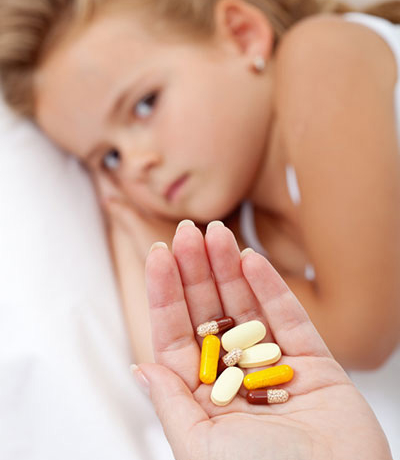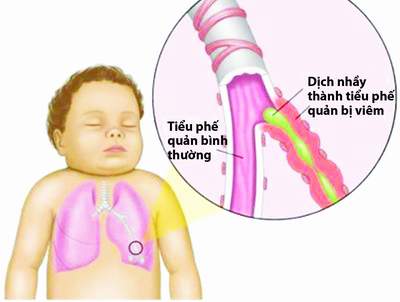Trẻ ho, viêm họng hay sổ mũi tuyệt đối không nên dùng kháng sinh
Trẻ ho, viêm họng hay sổ mũi tuyệt đối không nên dùng kháng sinh
Tác dụng phụ của thuốc kháng sinh là một trong những lý do chính khiến trẻ phải nhập viện khẩn cấp liên quan đến tiêu chảy, nôn mửa và các phản ứng dị ứng nguy hiểm khác.
Rất nhiều mẹ có thói quen cho trẻ uống kháng sinh một cách “vô tội vạ”, thậm chí chỉ cần con ho hay sổ mũi cũng nghĩ ngay đến kháng sinh. Tuy nhiên, trẻ không thực sự cần dùng kháng sinh nếu có các vấn đề về đường hô hấp như viêm họng, ho và chảy nước mũi. Trong những trường hợp này, thuốc kháng sinh còn có hại hơn là giúp trẻ cải thiện sức khỏe nhanh chóng.
Thuốc kháng sinh chỉ tiêu diệt vi khuẩn, không phải virut
Nếu bé bị nhiễm khuẩn, thuốc kháng sinh có thể giúp ngăn ngừa vi khuẩn tấn công cơ thể con. Nhưng nếu trẻ bị nhiễm virut, trong mọi trường hợp gần như thuốc kháng sinh vô tác dụng. Mẹ có biết:
• Hầu hết các loại cảm lạnh và cúm đều do virut gây ra.
• Viêm phế quản cũng là do virut. Viêm phế quản thường đi kèm với ho, có đờm và chất nhầy ở cổ họng, mũi.
• Hầu hết các loại viêm xoang cũng xảy ra do virut.
Thuốc kháng sinh không giúp trẻ khỏi bệnh
Thông thường, thuốc kháng sinh không thể chống lại được cảm lạnh, cúm, viêm phế quản và viêm xoang vì các loại bệnh trên đều do virut gây ra. Đôi khi vi khuẩn gây nhiễm trùng xoang, nhưng sau đó nhiễm trùng sẽ tự khỏi trong khoảng một tuần. Một vài loại nhiễm trùng tai cũng tự khỏi mà không cần dùng đến thuốc kháng sinh.
Dùng thuốc kháng sinh có thể gặp rủi ro
Tác dụng phụ của thuốc kháng sinh là một trong những lý do chính khiến trẻ phải nhập viện khẩn cấp. Thuốc kháng sinh có thể gây ra tiêu chảy, nôn mửa. 5/100 trẻ em cũng có triệu chứng dị ứng với các loại thuốc kháng sinh.
Sử dụng thuốc kháng sinh liều cao cũng làm vi khuẩn thay đổi mạnh mẽ hơn và kháng thuốc. Điều này có nghĩa là lần sau con bạn dùng thuốc kháng sinh, thuốc sẽ không có tác dụng.
Dùng thuốc kháng sinh gây lãng phí
Rất nhiều bà mẹ tin vào công dụng của thuốc kháng sinh nên không bao giờ tiếc tiền vào việc mua thuốc kháng sinh đắt tiền để điều trị bệnh cho trẻ nhỏ. Như đã nói ở trên, đây là cách họ “ném tiền qua cửa sổ” và còn khiến sức đề kháng tự nhiên của trẻ bị yếu.
Các trường hợp trẻ nhỏ cần dùng thuốc kháng sinh
Thuốc kháng sinh chỉ có tác dụng nếu bạn sử dụng đúng bệnh, đúng cách và đúng lúc, bao gồm các trường hợp sau:
• Ho không cải thiện trong 14 ngày.
• Xét nghiệm chỉ ra trẻ bị bệnh liên quan đến vi khuẩn (ví dụ như ho gà).
• Các triệu chứng của bệnh viêm xoang không thuyên giảm sau 10 ngày.
• Trẻ có dịch nhầy màu vàng xanh từ mũi và nhiệt độ cao trên 38 độ kéo dài một vài ngày.
• Trẻ bị viêm họng do liên cầu khuẩn.
Nguồn:http://www.healthychildren.org/English/safety-prevention/at-home/medication-safety/Pages/Antibiotics-for-a-Sore-Throat-Cough-or-Runny-Nose.aspx
Antibiotics for a Sore Throat, Cough or Runny Nose?
If your child has a sore throat, cough, or runny nose, you might expect the doctor to prescribe antibiotics. But most of the time, children don’t need antibiotics to treat a respiratory illness. In fact, antibiotics can do more harm than good. Here’s why:
Antibiotics fight bacteria, not viruses.
If your child has a bacterial infection, antibiotics may help. But if your child has a virus, antibiotics will not help your child feel better or keep others from getting sick.
- Most colds and flus are viruses.
- Chest colds, such as bronchitis, are also usually caused by viruses. Bronchitis is a cough with a lot of thick, sticky phlegm or mucus. Cigarette smoke and particles in the air can also cause bronchitis. But bacteria are not usually the cause.
- Most sinus infections (sinusitis) are also from viruses. The symptoms are a lot of mucus in the nose and post-nasal drip. Mucus that is colored does not necessarily mean your child has a bacterial infection.
In most cases, antibiotics will not help your child.
Usually, antibiotics do not work against colds, flu, bronchitis, or sinus infections because these are viruses. Sometimes bacteria cause sinus infections, but even then the infection usually clears up on its own in a week or so. Many common ear infections also clear up on their own without antibiotics.Some sore throats, like strep throat, are bacterial infections. Symptoms include fever, redness, and trouble swallowing. However, most children who have these symptoms do not have strep throat. Your child should have a strep test to confirm that it’s strep, and then, if they’re needed, the doctor will prescribe antibiotics.
Antibiotics have risks.
Side effects from antibiotics are a common reason that children go to the emergency room. The drugs can cause diarrhea or vomiting, and about 5 in 100 children have allergies to them. Some of these allergic reactions can be serious and life threatening.
Overusing antibiotics also encourages stronger bacteria to grow. The stronger bacteria do not respond to antibiotics. This means that the next time your child needs antibiotics for a bacterial infection, they will not work as well. This is sometimes called “antibiotic resistance.” The stronger bacteria can spread from your child to other family members and schoolmates, causing infections that are more difficult to cure and more costly to treat.
Antibiotics are a waste of money if used incorrectly.
Most antibiotics do not cost a lot. But money spent on drugs that are not needed is money wasted. Also, in severe cases, treatment of infections that are antibiotic-resistant can cost as much as $29,000.When does your child need antibiotics?
Your child may need antibiotics if:
- A cough does not get better in 14 days.
- A bacterial form of pneumonia or whooping cough (pertussis) is diagnosed.
- Symptoms of a sinus infection do not get better in ten days, or they get better and then worse again.
- Your child has a yellow-green nasal discharge and a fever of at least 102° F for several days in a row.
- Your child has strep throat, based on a rapid strep test or a throat culture. Antibiotics should not be prescribed unless one of the tests shows strep. Strep cannot be diagnosed just by looking at the throat.
This consumer information is part of the Choosing Wisely communications program and has been developed by Consumer Reports in collaboration with AAP and is being provided by HealthyChildren.org with the permission of Consumer Reports.
- Last Updated
- 8/20/2015
- Source
- Copyright © 2012 Consumer Reports. Developed in cooperation with the American Academy of Pediatrics.






There are no comments